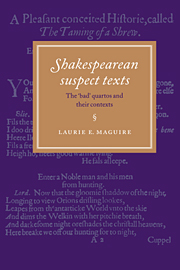3 - Memorial reconstruction and its discontents
Published online by Cambridge University Press: 19 October 2009
Summary
A theory is only an hypothesis in which we believe, and all history no less than all science is founded on such. The important question is what reason we have for believing it.
W.W.GregIt is not every-one's business to let himself be convinced.
Alexander SchmidtThe response to the New Bibliography was enthusiastic. New Bibliography's ‘scientific method’ represented ‘a long-overdue revolt against the sterile warfare of theory-mongers, and cleared the air with an invigorating breeze of good sense’; it gave ‘Shakespearean scholarship a new confidence, infusing into it a new spirit of optimism’; the result was ‘that the history of literature will have to be largely re-written’. A specific focus of praise was the identification of suspect texts as memorial reconstructions by actors. ‘The establishment of the Orlando class of “bad” Quartos is the most important development… in the study of pirated dramatic texts’; ‘the chief achievement of the Greg school of… scientific bibliography [is] the distinction between “good” and “bad” quartos’.
Theories of memorial reconstruction did not begin with the New Bibliographers. The use of memory in reporting playtexts had been suggested by editors of Shakespeare from the nineteenth century. In 1842 and 1843, respectively, Collier attributed Q1 Romeo and Juliet and Q1 Hamlet to shorthand notes, supplemented by the compiler's memory, or by assistance from an ‘inferior writer’.
- Type
- Chapter
- Information
- Shakespearean Suspect TextsThe 'Bad' Quartos and their Contexts, pp. 73 - 94Publisher: Cambridge University PressPrint publication year: 1996



